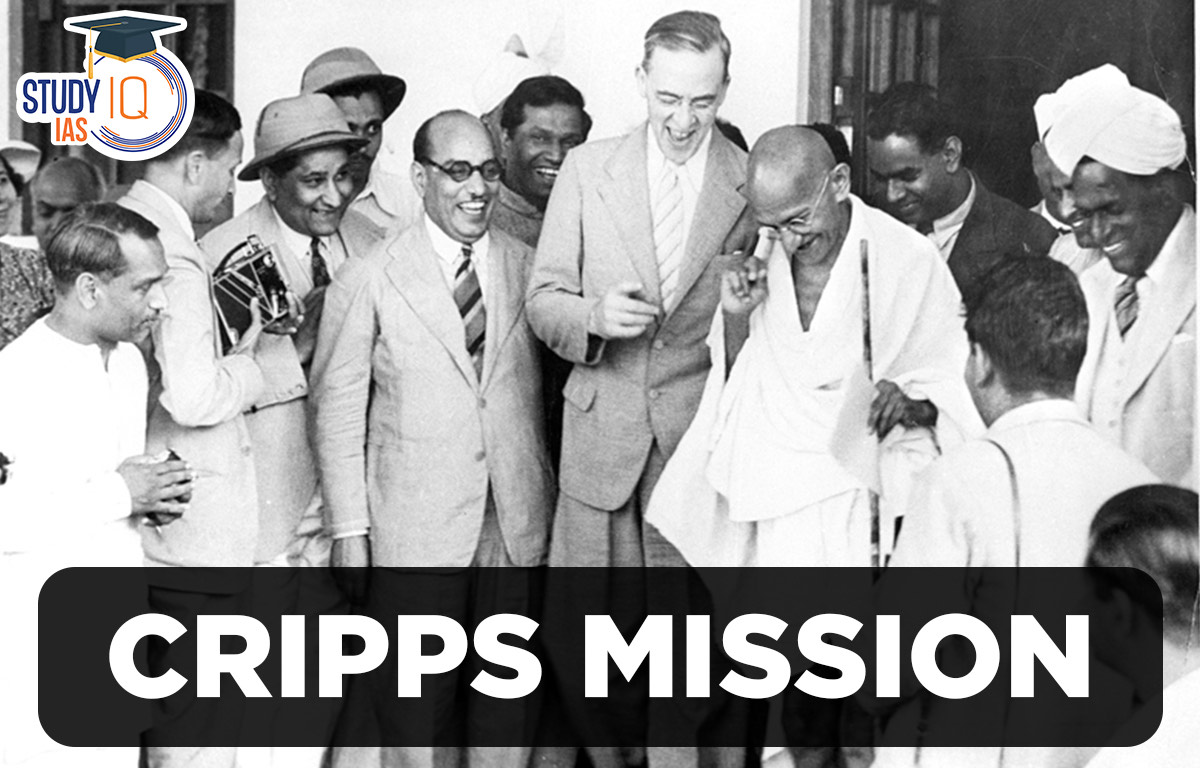Table of Contents
The Cripps Mission was sent by the British government to India in March 1942 to obtain Indian cooperation for the British war efforts in the 2nd World War. The mission was headed by a senior minister Stafford Cripps. Check out all the details about Cripps Mission in this article.
Cripps Mission
In order to secure Indian support for British war efforts during the Second World War, the British government dispatched the Cripps Mission to India in March 1942. Sir Richard Stafford Cripps, a minister for labour in Winston Churchill’s coalition administration in Britain, served as its leader. The US and other allied leaders put pressure on Britain for its own imperial practices in India and to win India’s assistance for the Allied war effort. The British government decided to send Cripps to India as a result of this.
| Cripps Mission | |
|---|---|
| Date | March 1942 |
| Leader | Sir Stafford Cripps |
| Objective | To secure Indian cooperation in the British war effort during World War II |
| Main Proposals |
|
| Response by Indian Leaders |
|
| Outcome | Failure, as neither the Congress nor the Muslim League accepted the proposals |
| Significance |
|
Cripps Mission Background
- World War II Context: The Cripps Mission took place during World War II, a time when British India was a crucial part of the British Empire. India’s participation in the war was essential for Britain’s war efforts, both militarily and economically.
- Rising Demands for Independence: The war provided an impetus for Indian political leaders to demand independence from British rule. The Quit India Movement of 1942, led by the Indian National Congress, was gaining momentum, demanding immediate and unconditional withdrawal of the British from India.
- British Strategic Concerns: The British were facing challenges in managing India amidst the war. They sought to secure Indian support for the war effort while maintaining control over the colony. Additionally, they were wary of the growing nationalist sentiment in India and its potential to escalate into widespread unrest.
Cripps Mission Main Proposals
The main proposals of the Cripps Mission were aimed at addressing Indian demands for self-governance while also ensuring continued Indian cooperation in Britain’s war efforts. Here are the key proposals:
- Dominion Status: The Cripps Mission proposed granting India dominion status within the British Commonwealth after the conclusion of World War II. Dominion status implied a significant degree of self-government and autonomy, similar to that enjoyed by other dominion countries like Canada and Australia.
- Constituent Assembly: The mission suggested the establishment of a Constituent Assembly consisting of Indian representatives. This assembly would be responsible for drafting a new constitution for India. The members of the assembly would be elected by the provincial legislatures, with the princely states also having the option to send representatives.
- Provincial Autonomy: The proposals aimed to grant considerable autonomy to the provinces within India. The provinces would have the authority to legislate on matters within their jurisdiction, with the central government retaining control over defense, foreign affairs, and communications.
- Defense and War Efforts: The Cripps Mission emphasized the importance of Indian cooperation in Britain’s war efforts. It promised that India would be given full independence once the war was over, provided that India remained united and continued to support the war effort.
- Guarantees for Minorities: The mission offered assurances to India’s minority communities, particularly Muslims. It proposed that any province would have the option to opt-out of the Constituent Assembly’s decisions if its minority community was not satisfied with the proposed constitution.
Cripps Mission Failure
- The British and the INC, who desired total independence, both viewed the measures as being too conservative and too radical, respectively.
- The Muslim League, the INC, and other Indian organisations also rejected the Mission.
- The Liberals and the Hindu Mahasabha opposed states’ rights to secede.
- Because they were concerned about their position in a nation where they would be a minority, the Depressed Classes objected.
- The Viceroy Linlithgow, British Prime Minister Winston Churchill, and Secretary of State for India Leo Amery are also thought to have refused to assist the expedition, which is another reason why it is thought to have failed.
Congress objected to:
1. Offering dominion status as an alternative to a clause mandating total independence;
2. The princely states are represented by nominations rather than elected representatives;
3. Right of provinces to secede as this violated the idea of national unity; Absence of any plan for an immediate transfer of power;
4. Absence of any real share in defence; Retention of the Governor-supremacy; General’s Refusal to accept the demand that the Governor-General only serves as the constitutional head.
Cripps Mission Significance
- The British government officially recognised India’s ability to be a dominion for the first time.
- Indians can draft their own Constitution.
- Giving the provinces the option to form their union turned out to be a precedent for the country’s separation in 1947.
- The option to leave the Commonwealth implied eventual full sovereignty.
- Indians were promised a sizable portion of the administration during the transitional era.
Cripps Mission UPSC
Cripps Mission was sent to India to garner India’s support for the British in WW II in March 1942. India was made a party to the Second World War in 1939 by Viceroy Lord Linlithgow since it was a part of the British Empire. The Main proposals of Cripps Mission Setting up an Indian dominion and the Establishment of a constituent assembly. The British government officially recognised India’s ability to be a dominion for the first time. Indians can draft their own Constitution. The Muslim League, the INC, and other Indian organisations also rejected the Mission. The Liberals and the Hindu Mahasabha opposed states’ rights to secede.


 Revival of Machilipatnam Port in Andhra ...
Revival of Machilipatnam Port in Andhra ...
 Nagari Pracharini Sabha Revival: Backgro...
Nagari Pracharini Sabha Revival: Backgro...
 Ryotwari System in India, Features, Impa...
Ryotwari System in India, Features, Impa...





















